【机器学习】Gradient Descent for Logistic Regression
Gradient Descent for Logistic Regression
- 1. 数据集(多变量)
- 2. 逻辑梯度下降
- 3. 梯度下降的实现及代码描述
- 3.1 计算梯度
- 3.2 梯度下降
- 4. 数据集(单变量)
- 附录
导入所需的库
import copy, math
import numpy as np
%matplotlib widget
import matplotlib.pyplot as plt
from lab_utils_common import dlc, plot_data, plt_tumor_data, sigmoid, compute_cost_logistic
from plt_quad_logistic import plt_quad_logistic, plt_prob
plt.style.use('./deeplearning.mplstyle')
1. 数据集(多变量)
X_train = np.array([[0.5, 1.5], [1,1], [1.5, 0.5], [3, 0.5], [2, 2], [1, 2.5]])
y_train = np.array([0, 0, 0, 1, 1, 1])
fig,ax = plt.subplots(1,1,figsize=(4,4))
plot_data(X_train, y_train, ax)ax.axis([0, 4, 0, 3.5])
ax.set_ylabel('$x_1$', fontsize=12)
ax.set_xlabel('$x_0$', fontsize=12)
plt.show()
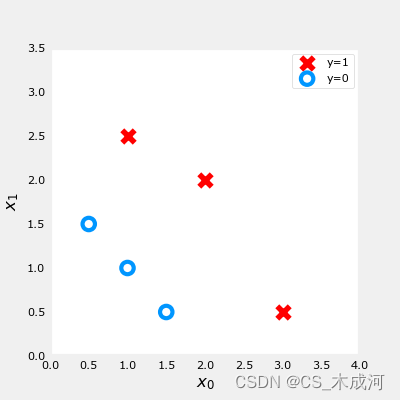
2. 逻辑梯度下降
梯度下降计算公式:
repeat until convergence: { w j = w j − α ∂ J ( w , b ) ∂ w j for j := 0..n-1 b = b − α ∂ J ( w , b ) ∂ b } \begin{align*} &\text{repeat until convergence:} \; \lbrace \\ & \; \; \;w_j = w_j - \alpha \frac{\partial J(\mathbf{w},b)}{\partial w_j} \tag{1} \; & \text{for j := 0..n-1} \\ & \; \; \; \; \;b = b - \alpha \frac{\partial J(\mathbf{w},b)}{\partial b} \\ &\rbrace \end{align*} repeat until convergence:{wj=wj−α∂wj∂J(w,b)b=b−α∂b∂J(w,b)}for j := 0..n-1(1)
其中,对于所有的 j j j 每次迭代同时更新 w j w_j wj ,
∂ J ( w , b ) ∂ w j = 1 m ∑ i = 0 m − 1 ( f w , b ( x ( i ) ) − y ( i ) ) x j ( i ) ∂ J ( w , b ) ∂ b = 1 m ∑ i = 0 m − 1 ( f w , b ( x ( i ) ) − y ( i ) ) \begin{align*} \frac{\partial J(\mathbf{w},b)}{\partial w_j} &= \frac{1}{m} \sum\limits_{i = 0}^{m-1} (f_{\mathbf{w},b}(\mathbf{x}^{(i)}) - y^{(i)})x_{j}^{(i)} \tag{2} \\ \frac{\partial J(\mathbf{w},b)}{\partial b} &= \frac{1}{m} \sum\limits_{i = 0}^{m-1} (f_{\mathbf{w},b}(\mathbf{x}^{(i)}) - y^{(i)}) \tag{3} \end{align*} ∂wj∂J(w,b)∂b∂J(w,b)=m1i=0∑m−1(fw,b(x(i))−y(i))xj(i)=m1i=0∑m−1(fw,b(x(i))−y(i))(2)(3)
- m 是训练集样例的数量
- f w , b ( x ( i ) ) f_{\mathbf{w},b}(x^{(i)}) fw,b(x(i)) 是模型预测值, y ( i ) y^{(i)} y(i) 是目标值
- 对于逻辑回归模型
z = w ⋅ x + b z = \mathbf{w} \cdot \mathbf{x} + b z=w⋅x+b
f w , b ( x ) = g ( z ) f_{\mathbf{w},b}(x) = g(z) fw,b(x)=g(z)
其中 g ( z ) g(z) g(z) 是 sigmoid 函数: g ( z ) = 1 1 + e − z g(z) = \frac{1}{1+e^{-z}} g(z)=1+e−z1
3. 梯度下降的实现及代码描述
实现梯度下降算法需要两步:
- 循环实现上面等式(1). 即下面的
gradient_descent - 当前梯度的计算等式(2, 3). 即下面的
compute_gradient_logistic
3.1 计算梯度
对于所有的 w j w_j wj 和 b b b,实现等式 (2),(3)
-
初始化变量计算
dj_dw和dj_db -
对每个样例:
- 计算误差 g ( w ⋅ x ( i ) + b ) − y ( i ) g(\mathbf{w} \cdot \mathbf{x}^{(i)} + b) - \mathbf{y}^{(i)} g(w⋅x(i)+b)−y(i)
- 对于这个样例中的每个输入值 x j ( i ) x_{j}^{(i)} xj(i) ,
- 误差乘以输入值 x j ( i ) x_{j}^{(i)} xj(i), 然后加到对应的
dj_dw中. (上述等式2)
- 误差乘以输入值 x j ( i ) x_{j}^{(i)} xj(i), 然后加到对应的
- 累加误差到
dj_db(上述等式3)
-
dj_db和dj_dw都除以样例总数 m m m -
在Numpy中 x ( i ) \mathbf{x}^{(i)} x(i) 是
X[i,:]或者X[i], x j ( i ) x_{j}^{(i)} xj(i) 是X[i,j]
代码描述:
def compute_gradient_logistic(X, y, w, b): """Computes the gradient for linear regression Args:X (ndarray (m,n): Data, m examples with n featuresy (ndarray (m,)): target valuesw (ndarray (n,)): model parameters b (scalar) : model parameterReturnsdj_dw (ndarray (n,)): The gradient of the cost w.r.t. the parameters w. dj_db (scalar) : The gradient of the cost w.r.t. the parameter b. """m,n = X.shapedj_dw = np.zeros((n,)) #(n,)dj_db = 0.for i in range(m):f_wb_i = sigmoid(np.dot(X[i],w) + b) #(n,)(n,)=scalarerr_i = f_wb_i - y[i] #scalarfor j in range(n):dj_dw[j] = dj_dw[j] + err_i * X[i,j] #scalardj_db = dj_db + err_idj_dw = dj_dw/m #(n,)dj_db = dj_db/m #scalarreturn dj_db, dj_dw
测试一下
X_tmp = np.array([[0.5, 1.5], [1,1], [1.5, 0.5], [3, 0.5], [2, 2], [1, 2.5]])
y_tmp = np.array([0, 0, 0, 1, 1, 1])
w_tmp = np.array([2.,3.])
b_tmp = 1.
dj_db_tmp, dj_dw_tmp = compute_gradient_logistic(X_tmp, y_tmp, w_tmp, b_tmp)
print(f"dj_db: {dj_db_tmp}" )
print(f"dj_dw: {dj_dw_tmp.tolist()}" )

3.2 梯度下降
实现上述公式(1),代码为:
def gradient_descent(X, y, w_in, b_in, alpha, num_iters): """Performs batch gradient descentArgs:X (ndarray (m,n) : Data, m examples with n featuresy (ndarray (m,)) : target valuesw_in (ndarray (n,)): Initial values of model parameters b_in (scalar) : Initial values of model parameteralpha (float) : Learning ratenum_iters (scalar) : number of iterations to run gradient descentReturns:w (ndarray (n,)) : Updated values of parametersb (scalar) : Updated value of parameter """# An array to store cost J and w's at each iteration primarily for graphing laterJ_history = []w = copy.deepcopy(w_in) #avoid modifying global w within functionb = b_infor i in range(num_iters):# Calculate the gradient and update the parametersdj_db, dj_dw = compute_gradient_logistic(X, y, w, b) # Update Parameters using w, b, alpha and gradientw = w - alpha * dj_dw b = b - alpha * dj_db # Save cost J at each iterationif i<100000: # prevent resource exhaustion J_history.append( compute_cost_logistic(X, y, w, b) )# Print cost every at intervals 10 times or as many iterations if < 10if i% math.ceil(num_iters / 10) == 0:print(f"Iteration {i:4d}: Cost {J_history[-1]} ")return w, b, J_history #return final w,b and J history for graphing
运行一下:
w_tmp = np.zeros_like(X_train[0])
b_tmp = 0.
alph = 0.1
iters = 10000w_out, b_out, _ = gradient_descent(X_train, y_train, w_tmp, b_tmp, alph, iters)
print(f"\nupdated parameters: w:{w_out}, b:{b_out}")

梯度下降的结果可视化:
fig,ax = plt.subplots(1,1,figsize=(5,4))
# plot the probability
plt_prob(ax, w_out, b_out)# Plot the original data
ax.set_ylabel(r'$x_1$')
ax.set_xlabel(r'$x_0$')
ax.axis([0, 4, 0, 3.5])
plot_data(X_train,y_train,ax)# Plot the decision boundary
x0 = -b_out/w_out[1]
x1 = -b_out/w_out[0]
ax.plot([0,x0],[x1,0], c=dlc["dlblue"], lw=1)
plt.show()
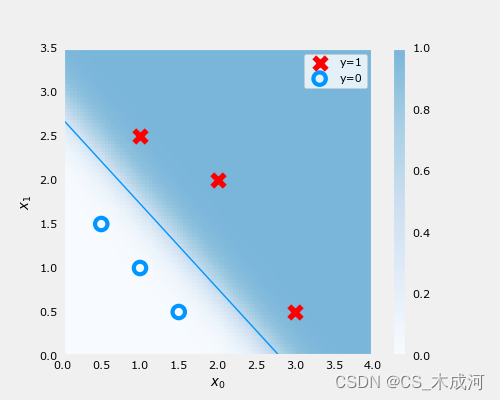
在上图中,阴影部分表示概率 y=1,决策边界是概率为0.5的直线。
4. 数据集(单变量)
导入数据绘图可视化,此时参数为 w w w, b b b:
x_train = np.array([0., 1, 2, 3, 4, 5])
y_train = np.array([0, 0, 0, 1, 1, 1])fig,ax = plt.subplots(1,1,figsize=(4,3))
plt_tumor_data(x_train, y_train, ax)
plt.show()
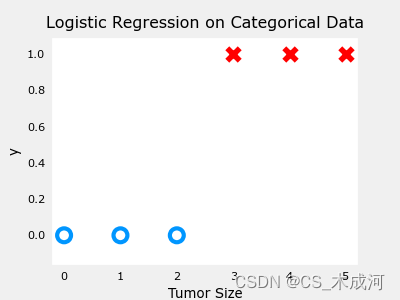
w_range = np.array([-1, 7])
b_range = np.array([1, -14])
quad = plt_quad_logistic( x_train, y_train, w_range, b_range )
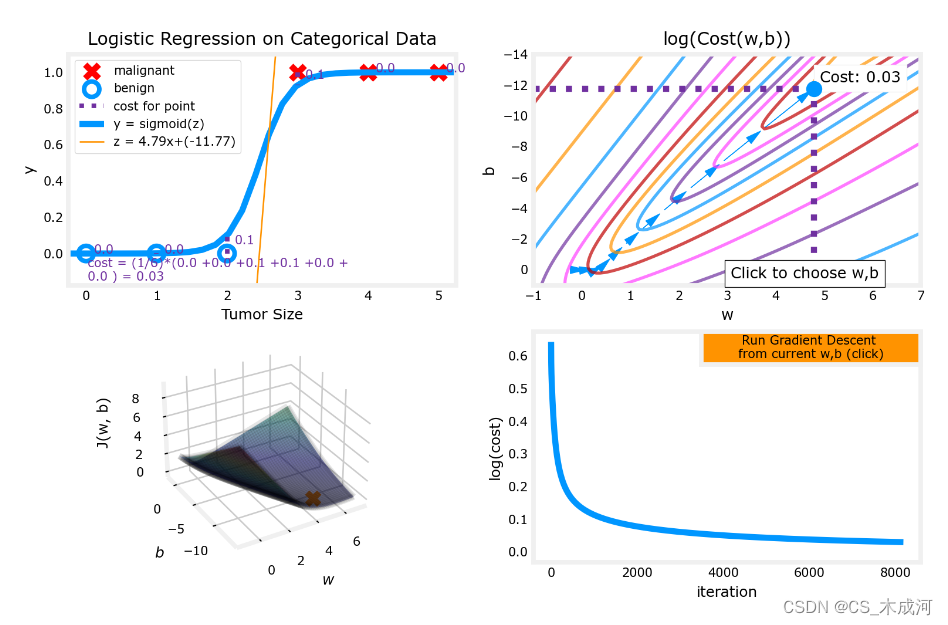
附录
lab_utils_common.py 源码:
"""
lab_utils_commoncontains common routines and variable definitionsused by all the labs in this week.by contrast, specific, large plotting routines will be in separate filesand are generally imported into the week where they are used.those files will import this file
"""
import copy
import math
import numpy as np
import matplotlib.pyplot as plt
from matplotlib.patches import FancyArrowPatch
from ipywidgets import Outputnp.set_printoptions(precision=2)dlc = dict(dlblue = '#0096ff', dlorange = '#FF9300', dldarkred='#C00000', dlmagenta='#FF40FF', dlpurple='#7030A0')
dlblue = '#0096ff'; dlorange = '#FF9300'; dldarkred='#C00000'; dlmagenta='#FF40FF'; dlpurple='#7030A0'
dlcolors = [dlblue, dlorange, dldarkred, dlmagenta, dlpurple]
plt.style.use('./deeplearning.mplstyle')def sigmoid(z):"""Compute the sigmoid of zParameters----------z : array_likeA scalar or numpy array of any size.Returns-------g : array_likesigmoid(z)"""z = np.clip( z, -500, 500 ) # protect against overflowg = 1.0/(1.0+np.exp(-z))return g##########################################################
# Regression Routines
##########################################################def predict_logistic(X, w, b):""" performs prediction """return sigmoid(X @ w + b)def predict_linear(X, w, b):""" performs prediction """return X @ w + bdef compute_cost_logistic(X, y, w, b, lambda_=0, safe=False):"""Computes cost using logistic loss, non-matrix versionArgs:X (ndarray): Shape (m,n) matrix of examples with n featuresy (ndarray): Shape (m,) target valuesw (ndarray): Shape (n,) parameters for predictionb (scalar): parameter for predictionlambda_ : (scalar, float) Controls amount of regularization, 0 = no regularizationsafe : (boolean) True-selects under/overflow safe algorithmReturns:cost (scalar): cost"""m,n = X.shapecost = 0.0for i in range(m):z_i = np.dot(X[i],w) + b #(n,)(n,) or (n,) ()if safe: #avoids overflowscost += -(y[i] * z_i ) + log_1pexp(z_i)else:f_wb_i = sigmoid(z_i) #(n,)cost += -y[i] * np.log(f_wb_i) - (1 - y[i]) * np.log(1 - f_wb_i) # scalarcost = cost/mreg_cost = 0if lambda_ != 0:for j in range(n):reg_cost += (w[j]**2) # scalarreg_cost = (lambda_/(2*m))*reg_costreturn cost + reg_costdef log_1pexp(x, maximum=20):''' approximate log(1+exp^x)https://stats.stackexchange.com/questions/475589/numerical-computation-of-cross-entropy-in-practiceArgs:x : (ndarray Shape (n,1) or (n,) inputout : (ndarray Shape matches x output ~= np.log(1+exp(x))'''out = np.zeros_like(x,dtype=float)i = x <= maximumni = np.logical_not(i)out[i] = np.log(1 + np.exp(x[i]))out[ni] = x[ni]return outdef compute_cost_matrix(X, y, w, b, logistic=False, lambda_=0, safe=True):"""Computes the cost using using matricesArgs:X : (ndarray, Shape (m,n)) matrix of examplesy : (ndarray Shape (m,) or (m,1)) target value of each examplew : (ndarray Shape (n,) or (n,1)) Values of parameter(s) of the modelb : (scalar ) Values of parameter of the modelverbose : (Boolean) If true, print out intermediate value f_wbReturns:total_cost: (scalar) cost"""m = X.shape[0]y = y.reshape(-1,1) # ensure 2Dw = w.reshape(-1,1) # ensure 2Dif logistic:if safe: #safe from overflowz = X @ w + b #(m,n)(n,1)=(m,1)cost = -(y * z) + log_1pexp(z)cost = np.sum(cost)/m # (scalar)else:f = sigmoid(X @ w + b) # (m,n)(n,1) = (m,1)cost = (1/m)*(np.dot(-y.T, np.log(f)) - np.dot((1-y).T, np.log(1-f))) # (1,m)(m,1) = (1,1)cost = cost[0,0] # scalarelse:f = X @ w + b # (m,n)(n,1) = (m,1)cost = (1/(2*m)) * np.sum((f - y)**2) # scalarreg_cost = (lambda_/(2*m)) * np.sum(w**2) # scalartotal_cost = cost + reg_cost # scalarreturn total_cost # scalardef compute_gradient_matrix(X, y, w, b, logistic=False, lambda_=0):"""Computes the gradient using matricesArgs:X : (ndarray, Shape (m,n)) matrix of examplesy : (ndarray Shape (m,) or (m,1)) target value of each examplew : (ndarray Shape (n,) or (n,1)) Values of parameters of the modelb : (scalar ) Values of parameter of the modellogistic: (boolean) linear if false, logistic if truelambda_: (float) applies regularization if non-zeroReturnsdj_dw: (array_like Shape (n,1)) The gradient of the cost w.r.t. the parameters wdj_db: (scalar) The gradient of the cost w.r.t. the parameter b"""m = X.shape[0]y = y.reshape(-1,1) # ensure 2Dw = w.reshape(-1,1) # ensure 2Df_wb = sigmoid( X @ w + b ) if logistic else X @ w + b # (m,n)(n,1) = (m,1)err = f_wb - y # (m,1)dj_dw = (1/m) * (X.T @ err) # (n,m)(m,1) = (n,1)dj_db = (1/m) * np.sum(err) # scalardj_dw += (lambda_/m) * w # regularize # (n,1)return dj_db, dj_dw # scalar, (n,1)def gradient_descent(X, y, w_in, b_in, alpha, num_iters, logistic=False, lambda_=0, verbose=True):"""Performs batch gradient descent to learn theta. Updates theta by takingnum_iters gradient steps with learning rate alphaArgs:X (ndarray): Shape (m,n) matrix of examplesy (ndarray): Shape (m,) or (m,1) target value of each examplew_in (ndarray): Shape (n,) or (n,1) Initial values of parameters of the modelb_in (scalar): Initial value of parameter of the modellogistic: (boolean) linear if false, logistic if truelambda_: (float) applies regularization if non-zeroalpha (float): Learning ratenum_iters (int): number of iterations to run gradient descentReturns:w (ndarray): Shape (n,) or (n,1) Updated values of parameters; matches incoming shapeb (scalar): Updated value of parameter"""# An array to store cost J and w's at each iteration primarily for graphing laterJ_history = []w = copy.deepcopy(w_in) #avoid modifying global w within functionb = b_inw = w.reshape(-1,1) #prep for matrix operationsy = y.reshape(-1,1)for i in range(num_iters):# Calculate the gradient and update the parametersdj_db,dj_dw = compute_gradient_matrix(X, y, w, b, logistic, lambda_)# Update Parameters using w, b, alpha and gradientw = w - alpha * dj_dwb = b - alpha * dj_db# Save cost J at each iterationif i<100000: # prevent resource exhaustionJ_history.append( compute_cost_matrix(X, y, w, b, logistic, lambda_) )# Print cost every at intervals 10 times or as many iterations if < 10if i% math.ceil(num_iters / 10) == 0:if verbose: print(f"Iteration {i:4d}: Cost {J_history[-1]} ")return w.reshape(w_in.shape), b, J_history #return final w,b and J history for graphingdef zscore_normalize_features(X):"""computes X, zcore normalized by columnArgs:X (ndarray): Shape (m,n) input data, m examples, n featuresReturns:X_norm (ndarray): Shape (m,n) input normalized by columnmu (ndarray): Shape (n,) mean of each featuresigma (ndarray): Shape (n,) standard deviation of each feature"""# find the mean of each column/featuremu = np.mean(X, axis=0) # mu will have shape (n,)# find the standard deviation of each column/featuresigma = np.std(X, axis=0) # sigma will have shape (n,)# element-wise, subtract mu for that column from each example, divide by std for that columnX_norm = (X - mu) / sigmareturn X_norm, mu, sigma#check our work
#from sklearn.preprocessing import scale
#scale(X_orig, axis=0, with_mean=True, with_std=True, copy=True)######################################################
# Common Plotting Routines
######################################################def plot_data(X, y, ax, pos_label="y=1", neg_label="y=0", s=80, loc='best' ):""" plots logistic data with two axis """# Find Indices of Positive and Negative Examplespos = y == 1neg = y == 0pos = pos.reshape(-1,) #work with 1D or 1D y vectorsneg = neg.reshape(-1,)# Plot examplesax.scatter(X[pos, 0], X[pos, 1], marker='x', s=s, c = 'red', label=pos_label)ax.scatter(X[neg, 0], X[neg, 1], marker='o', s=s, label=neg_label, facecolors='none', edgecolors=dlblue, lw=3)ax.legend(loc=loc)ax.figure.canvas.toolbar_visible = Falseax.figure.canvas.header_visible = Falseax.figure.canvas.footer_visible = Falsedef plt_tumor_data(x, y, ax):""" plots tumor data on one axis """pos = y == 1neg = y == 0ax.scatter(x[pos], y[pos], marker='x', s=80, c = 'red', label="malignant")ax.scatter(x[neg], y[neg], marker='o', s=100, label="benign", facecolors='none', edgecolors=dlblue,lw=3)ax.set_ylim(-0.175,1.1)ax.set_ylabel('y')ax.set_xlabel('Tumor Size')ax.set_title("Logistic Regression on Categorical Data")ax.figure.canvas.toolbar_visible = Falseax.figure.canvas.header_visible = Falseax.figure.canvas.footer_visible = False# Draws a threshold at 0.5
def draw_vthresh(ax,x):""" draws a threshold """ylim = ax.get_ylim()xlim = ax.get_xlim()ax.fill_between([xlim[0], x], [ylim[1], ylim[1]], alpha=0.2, color=dlblue)ax.fill_between([x, xlim[1]], [ylim[1], ylim[1]], alpha=0.2, color=dldarkred)ax.annotate("z >= 0", xy= [x,0.5], xycoords='data',xytext=[30,5],textcoords='offset points')d = FancyArrowPatch(posA=(x, 0.5), posB=(x+3, 0.5), color=dldarkred,arrowstyle='simple, head_width=5, head_length=10, tail_width=0.0',)ax.add_artist(d)ax.annotate("z < 0", xy= [x,0.5], xycoords='data',xytext=[-50,5],textcoords='offset points', ha='left')f = FancyArrowPatch(posA=(x, 0.5), posB=(x-3, 0.5), color=dlblue,arrowstyle='simple, head_width=5, head_length=10, tail_width=0.0',)ax.add_artist(f)
plt_quad_logistic.py 源码:
"""
plt_quad_logistic.pyinteractive plot and supporting routines showing logistic regression
"""import time
from matplotlib import cm
import matplotlib.colors as colors
from matplotlib.gridspec import GridSpec
from matplotlib.widgets import Button
from matplotlib.patches import FancyArrowPatch
from ipywidgets import Output
from lab_utils_common import np, plt, dlc, dlcolors, sigmoid, compute_cost_matrix, gradient_descent# for debug
#output = Output() # sends hidden error messages to display when using widgets
#display(output)class plt_quad_logistic:''' plots a quad plot showing logistic regression '''# pylint: disable=too-many-instance-attributes# pylint: disable=too-many-locals# pylint: disable=missing-function-docstring# pylint: disable=attribute-defined-outside-initdef __init__(self, x_train,y_train, w_range, b_range):# setup figurefig = plt.figure( figsize=(10,6))fig.canvas.toolbar_visible = Falsefig.canvas.header_visible = Falsefig.canvas.footer_visible = Falsefig.set_facecolor('#ffffff') #whitegs = GridSpec(2, 2, figure=fig)ax0 = fig.add_subplot(gs[0, 0])ax1 = fig.add_subplot(gs[0, 1])ax2 = fig.add_subplot(gs[1, 0], projection='3d')ax3 = fig.add_subplot(gs[1,1])pos = ax3.get_position().get_points() ##[[lb_x,lb_y], [rt_x, rt_y]]h = 0.05 width = 0.2axcalc = plt.axes([pos[1,0]-width, pos[1,1]-h, width, h]) #lx,by,w,hax = np.array([ax0, ax1, ax2, ax3, axcalc])self.fig = figself.ax = axself.x_train = x_trainself.y_train = y_trainself.w = 0. #initial point, non-arrayself.b = 0.# initialize subplotsself.dplot = data_plot(ax[0], x_train, y_train, self.w, self.b)self.con_plot = contour_and_surface_plot(ax[1], ax[2], x_train, y_train, w_range, b_range, self.w, self.b)self.cplot = cost_plot(ax[3])# setup eventsself.cid = fig.canvas.mpl_connect('button_press_event', self.click_contour)self.bcalc = Button(axcalc, 'Run Gradient Descent \nfrom current w,b (click)', color=dlc["dlorange"])self.bcalc.on_clicked(self.calc_logistic)# @output.capture() # debugdef click_contour(self, event):''' called when click in contour '''if event.inaxes == self.ax[1]: #contour plotself.w = event.xdataself.b = event.ydataself.cplot.re_init()self.dplot.update(self.w, self.b)self.con_plot.update_contour_wb_lines(self.w, self.b)self.con_plot.path.re_init(self.w, self.b)self.fig.canvas.draw()# @output.capture() # debugdef calc_logistic(self, event):''' called on run gradient event '''for it in [1, 8,16,32,64,128,256,512,1024,2048,4096]:w, self.b, J_hist = gradient_descent(self.x_train.reshape(-1,1), self.y_train.reshape(-1,1),np.array(self.w).reshape(-1,1), self.b, 0.1, it,logistic=True, lambda_=0, verbose=False)self.w = w[0,0]self.dplot.update(self.w, self.b)self.con_plot.update_contour_wb_lines(self.w, self.b)self.con_plot.path.add_path_item(self.w,self.b)self.cplot.add_cost(J_hist)time.sleep(0.3)self.fig.canvas.draw()class data_plot:''' handles data plot '''# pylint: disable=missing-function-docstring# pylint: disable=attribute-defined-outside-initdef __init__(self, ax, x_train, y_train, w, b):self.ax = axself.x_train = x_trainself.y_train = y_trainself.m = x_train.shape[0]self.w = wself.b = bself.plt_tumor_data()self.draw_logistic_lines(firsttime=True)self.mk_cost_lines(firsttime=True)self.ax.autoscale(enable=False) # leave plot scales the same after initial setupdef plt_tumor_data(self):x = self.x_trainy = self.y_trainpos = y == 1neg = y == 0self.ax.scatter(x[pos], y[pos], marker='x', s=80, c = 'red', label="malignant")self.ax.scatter(x[neg], y[neg], marker='o', s=100, label="benign", facecolors='none',edgecolors=dlc["dlblue"],lw=3)self.ax.set_ylim(-0.175,1.1)self.ax.set_ylabel('y')self.ax.set_xlabel('Tumor Size')self.ax.set_title("Logistic Regression on Categorical Data")def update(self, w, b):self.w = wself.b = bself.draw_logistic_lines()self.mk_cost_lines()def draw_logistic_lines(self, firsttime=False):if not firsttime:self.aline[0].remove()self.bline[0].remove()self.alegend.remove()xlim = self.ax.get_xlim()x_hat = np.linspace(*xlim, 30)y_hat = sigmoid(np.dot(x_hat.reshape(-1,1), self.w) + self.b)self.aline = self.ax.plot(x_hat, y_hat, color=dlc["dlblue"],label="y = sigmoid(z)")f_wb = np.dot(x_hat.reshape(-1,1), self.w) + self.bself.bline = self.ax.plot(x_hat, f_wb, color=dlc["dlorange"], lw=1,label=f"z = {np.squeeze(self.w):0.2f}x+({self.b:0.2f})")self.alegend = self.ax.legend(loc='upper left')def mk_cost_lines(self, firsttime=False):''' makes vertical cost lines'''if not firsttime:for artist in self.cost_items:artist.remove()self.cost_items = []cstr = f"cost = (1/{self.m})*("ctot = 0label = 'cost for point'addedbreak = Falsefor p in zip(self.x_train,self.y_train):f_wb_p = sigmoid(self.w*p[0]+self.b)c_p = compute_cost_matrix(p[0].reshape(-1,1), p[1],np.array(self.w), self.b, logistic=True, lambda_=0, safe=True)c_p_txt = c_pa = self.ax.vlines(p[0], p[1],f_wb_p, lw=3, color=dlc["dlpurple"], ls='dotted', label=label)label='' #just onecxy = [p[0], p[1] + (f_wb_p-p[1])/2]b = self.ax.annotate(f'{c_p_txt:0.1f}', xy=cxy, xycoords='data',color=dlc["dlpurple"],xytext=(5, 0), textcoords='offset points')cstr += f"{c_p_txt:0.1f} +"if len(cstr) > 38 and addedbreak is False:cstr += "\n"addedbreak = Truectot += c_pself.cost_items.extend((a,b))ctot = ctot/(len(self.x_train))cstr = cstr[:-1] + f") = {ctot:0.2f}"## todo.. figure out how to get this textbox to extend to the width of the subplotc = self.ax.text(0.05,0.02,cstr, transform=self.ax.transAxes, color=dlc["dlpurple"])self.cost_items.append(c)class contour_and_surface_plot:''' plots combined in class as they have similar operations '''# pylint: disable=missing-function-docstring# pylint: disable=attribute-defined-outside-initdef __init__(self, axc, axs, x_train, y_train, w_range, b_range, w, b):self.x_train = x_trainself.y_train = y_trainself.axc = axcself.axs = axs#setup useful ranges and common linspacesb_space = np.linspace(*b_range, 100)w_space = np.linspace(*w_range, 100)# get cost for w,b ranges for contour and 3Dtmp_b,tmp_w = np.meshgrid(b_space,w_space)z = np.zeros_like(tmp_b)for i in range(tmp_w.shape[0]):for j in range(tmp_w.shape[1]):z[i,j] = compute_cost_matrix(x_train.reshape(-1,1), y_train, tmp_w[i,j], tmp_b[i,j],logistic=True, lambda_=0, safe=True)if z[i,j] == 0:z[i,j] = 1e-9### plot contour ###CS = axc.contour(tmp_w, tmp_b, np.log(z),levels=12, linewidths=2, alpha=0.7,colors=dlcolors)axc.set_title('log(Cost(w,b))')axc.set_xlabel('w', fontsize=10)axc.set_ylabel('b', fontsize=10)axc.set_xlim(w_range)axc.set_ylim(b_range)self.update_contour_wb_lines(w, b, firsttime=True)axc.text(0.7,0.05,"Click to choose w,b", bbox=dict(facecolor='white', ec = 'black'), fontsize = 10,transform=axc.transAxes, verticalalignment = 'center', horizontalalignment= 'center')#Surface plot of the cost function J(w,b)axs.plot_surface(tmp_w, tmp_b, z, cmap = cm.jet, alpha=0.3, antialiased=True)axs.plot_wireframe(tmp_w, tmp_b, z, color='k', alpha=0.1)axs.set_xlabel("$w$")axs.set_ylabel("$b$")axs.zaxis.set_rotate_label(False)axs.xaxis.set_pane_color((1.0, 1.0, 1.0, 0.0))axs.yaxis.set_pane_color((1.0, 1.0, 1.0, 0.0))axs.zaxis.set_pane_color((1.0, 1.0, 1.0, 0.0))axs.set_zlabel("J(w, b)", rotation=90)axs.view_init(30, -120)axs.autoscale(enable=False)axc.autoscale(enable=False)self.path = path(self.w,self.b, self.axc) # initialize an empty path, avoids existance checkdef update_contour_wb_lines(self, w, b, firsttime=False):self.w = wself.b = bcst = compute_cost_matrix(self.x_train.reshape(-1,1), self.y_train, np.array(self.w), self.b,logistic=True, lambda_=0, safe=True)# remove lines and re-add on contour plot and 3d plotif not firsttime:for artist in self.dyn_items:artist.remove()a = self.axc.scatter(self.w, self.b, s=100, color=dlc["dlblue"], zorder= 10, label="cost with \ncurrent w,b")b = self.axc.hlines(self.b, self.axc.get_xlim()[0], self.w, lw=4, color=dlc["dlpurple"], ls='dotted')c = self.axc.vlines(self.w, self.axc.get_ylim()[0] ,self.b, lw=4, color=dlc["dlpurple"], ls='dotted')d = self.axc.annotate(f"Cost: {cst:0.2f}", xy= (self.w, self.b), xytext = (4,4), textcoords = 'offset points',bbox=dict(facecolor='white'), size = 10)#Add point in 3D surface plote = self.axs.scatter3D(self.w, self.b, cst , marker='X', s=100)self.dyn_items = [a,b,c,d,e]class cost_plot:""" manages cost plot for plt_quad_logistic """# pylint: disable=missing-function-docstring# pylint: disable=attribute-defined-outside-initdef __init__(self,ax):self.ax = axself.ax.set_ylabel("log(cost)")self.ax.set_xlabel("iteration")self.costs = []self.cline = self.ax.plot(0,0, color=dlc["dlblue"])def re_init(self):self.ax.clear()self.__init__(self.ax)def add_cost(self,J_hist):self.costs.extend(J_hist)self.cline[0].remove()self.cline = self.ax.plot(self.costs)class path:''' tracks paths during gradient descent on contour plot '''# pylint: disable=missing-function-docstring# pylint: disable=attribute-defined-outside-initdef __init__(self, w, b, ax):''' w, b at start of path '''self.path_items = []self.w = wself.b = bself.ax = axdef re_init(self, w, b):for artist in self.path_items:artist.remove()self.path_items = []self.w = wself.b = bdef add_path_item(self, w, b):a = FancyArrowPatch(posA=(self.w, self.b), posB=(w, b), color=dlc["dlblue"],arrowstyle='simple, head_width=5, head_length=10, tail_width=0.0',)self.ax.add_artist(a)self.path_items.append(a)self.w = wself.b = b#-----------
# related to the logistic gradient descent lab
#----------def truncate_colormap(cmap, minval=0.0, maxval=1.0, n=100):""" truncates color map """new_cmap = colors.LinearSegmentedColormap.from_list('trunc({n},{a:.2f},{b:.2f})'.format(n=cmap.name, a=minval, b=maxval),cmap(np.linspace(minval, maxval, n)))return new_cmapdef plt_prob(ax, w_out,b_out):""" plots a decision boundary but include shading to indicate the probability """#setup useful ranges and common linspacesx0_space = np.linspace(0, 4 , 100)x1_space = np.linspace(0, 4 , 100)# get probability for x0,x1 rangestmp_x0,tmp_x1 = np.meshgrid(x0_space,x1_space)z = np.zeros_like(tmp_x0)for i in range(tmp_x0.shape[0]):for j in range(tmp_x1.shape[1]):z[i,j] = sigmoid(np.dot(w_out, np.array([tmp_x0[i,j],tmp_x1[i,j]])) + b_out)cmap = plt.get_cmap('Blues')new_cmap = truncate_colormap(cmap, 0.0, 0.5)pcm = ax.pcolormesh(tmp_x0, tmp_x1, z,norm=cm.colors.Normalize(vmin=0, vmax=1),cmap=new_cmap, shading='nearest', alpha = 0.9)ax.figure.colorbar(pcm, ax=ax)
相关文章:

【机器学习】Gradient Descent for Logistic Regression
Gradient Descent for Logistic Regression 1. 数据集(多变量)2. 逻辑梯度下降3. 梯度下降的实现及代码描述3.1 计算梯度3.2 梯度下降 4. 数据集(单变量)附录 导入所需的库 import copy, math import numpy as np %matplotlib wi…...

ElasticSearch基础篇-Java API操作
ElasticSearch基础-Java API操作 演示代码 创建连接 POM依赖 <?xml version"1.0" encoding"UTF-8"?> <project xmlns"http://maven.apache.org/POM/4.0.0"xmlns:xsi"http://www.w3.org/2001/XMLSchema-instance"xsi:sch…...
解决uniapp的tabBar使用iconfont图标显示方块
今天要写个uniapp的移动端项目,底部tabBar需要添加图标,以往都是以图片的形式引入,但是考虑到不同甲方的主题色也不会相同,使用图片的话,后期变换主题色并不友好,所以和UI商量之后,决定使用icon…...
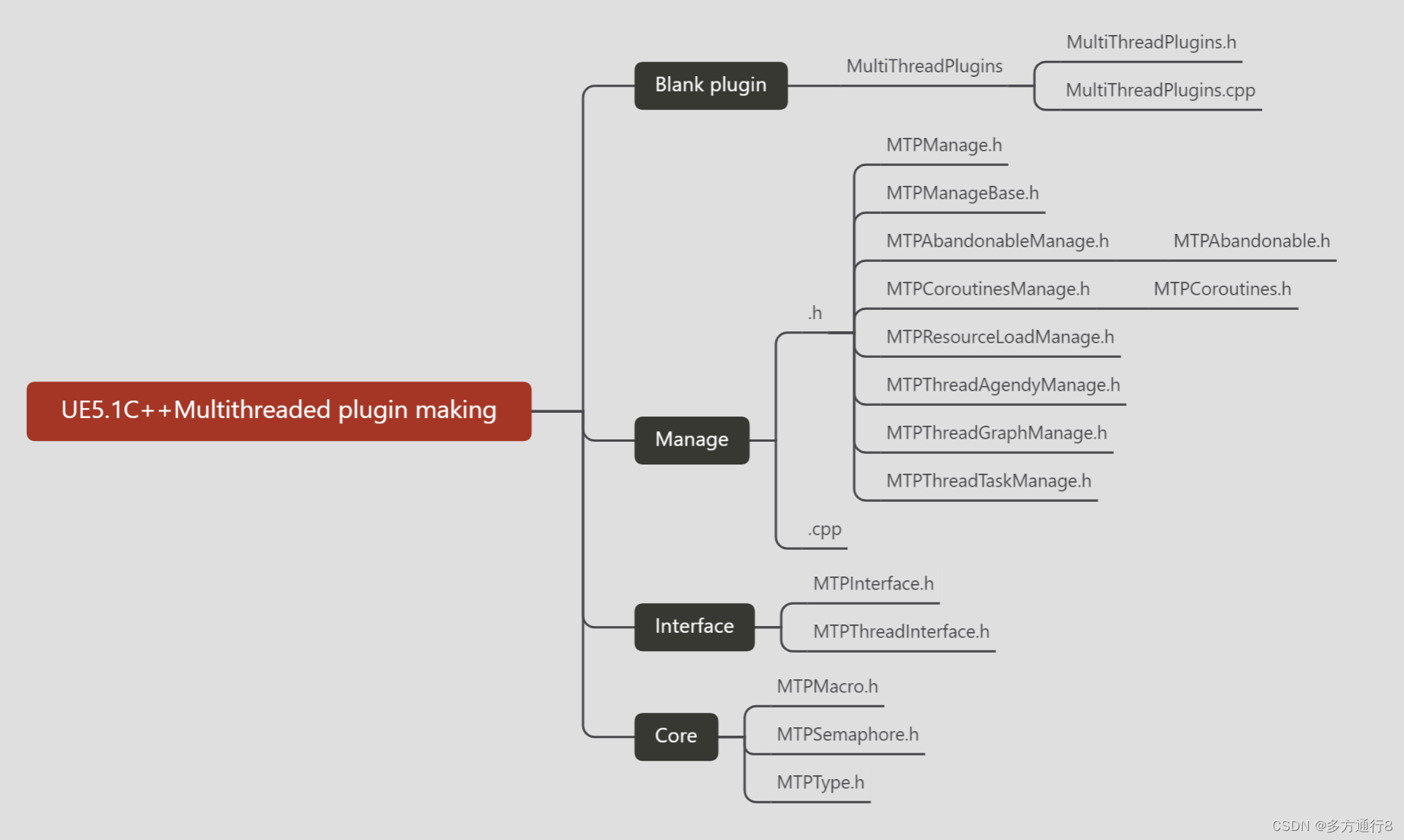
UE4/5C++多线程插件制作(0.简介)
目录 插件介绍 插件效果 插件使用 English 插件介绍 该插件制作,将从零开始,由一个空白插件一点点的制作,从写一个效果到封装,层层封装插件,简单粗暴的对插件进行了制作: 插件效果 更多的是在cpp中去…...
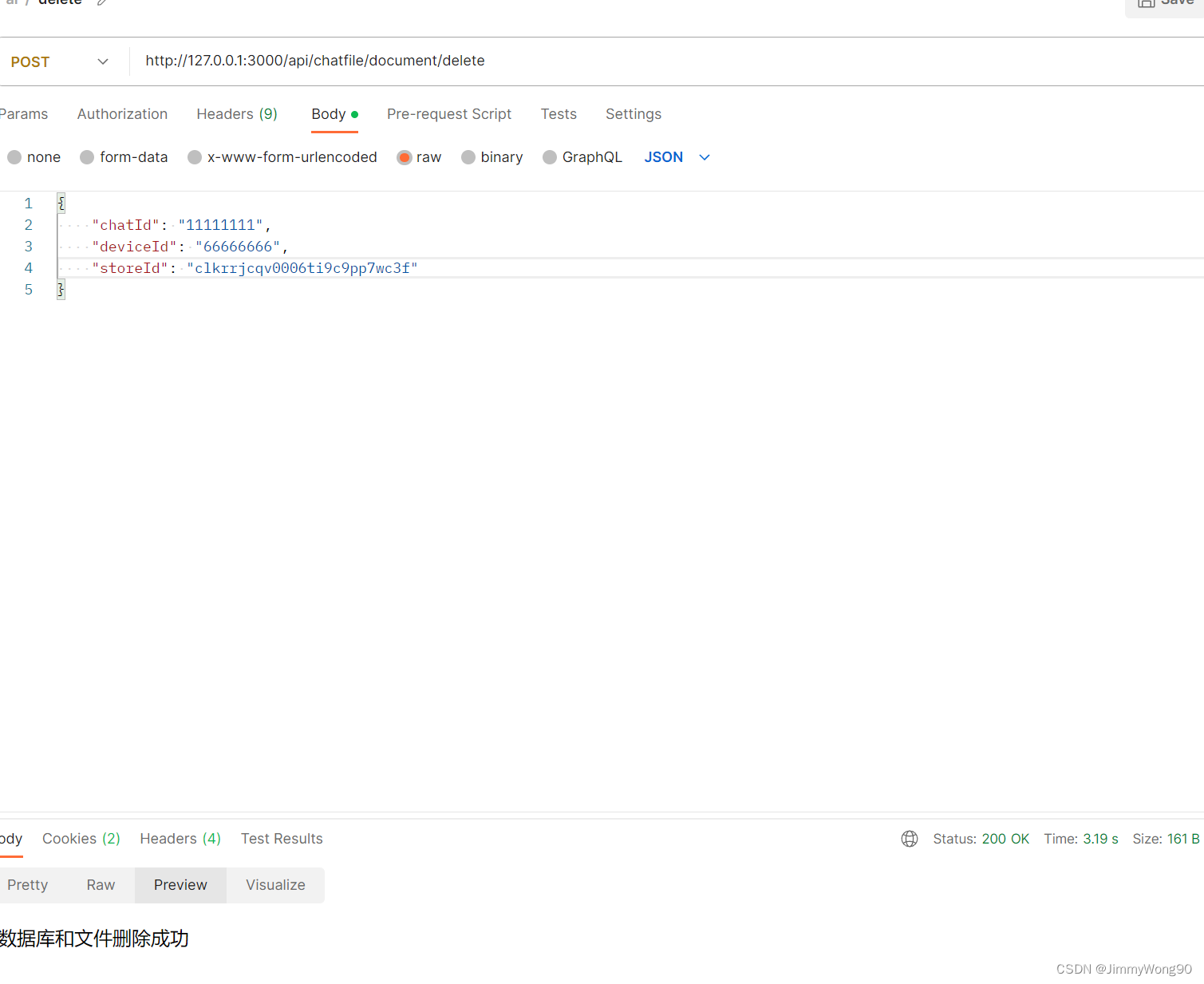
ChatFile实现相关流程
文本上传构建向量库后台库的内容 调用上传文件接口先上传文件 存在疑问:暂时是把文件保存在tmp文件夹,定时清理,是否使用云存储 根据不同的文件类型选取不同的文件加载器加载文件内容 switch (file.mimetype) {case application/pdf:loader new PDFLoader(file.path)breakc…...
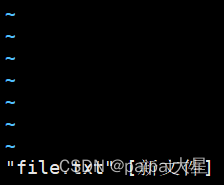
15 文本编辑器vim
15.1 建立文件命令 如果file.txt就是修改这个文件,如果不存在就是新建一个文件。 vim file.txt 使用vim建完文件后,会自动进入文件中。 15.2 切换模式 底部要是显示插入,是编辑模式; 按esc,底部要是空白的࿰…...
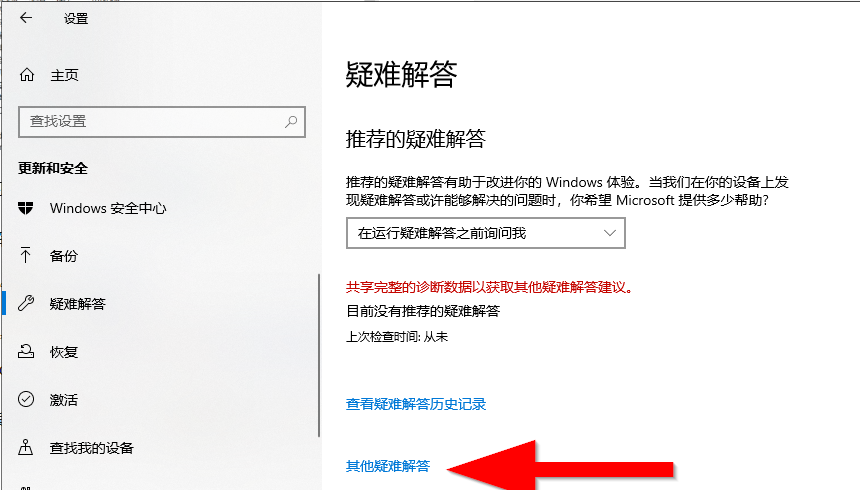
如何运行疑难解答程序来查找和修复Windows 10中的常见问题
如果Windows 10中出现问题,运行疑难解答可能会有所帮助。疑难解答人员可以为你找到并解决许多常见问题。 一、在控制面板中运行疑难解答 1、打开控制面板(图标视图),然后单击“疑难解答”图标。 2、单击“疑难解答”中左上角的…...
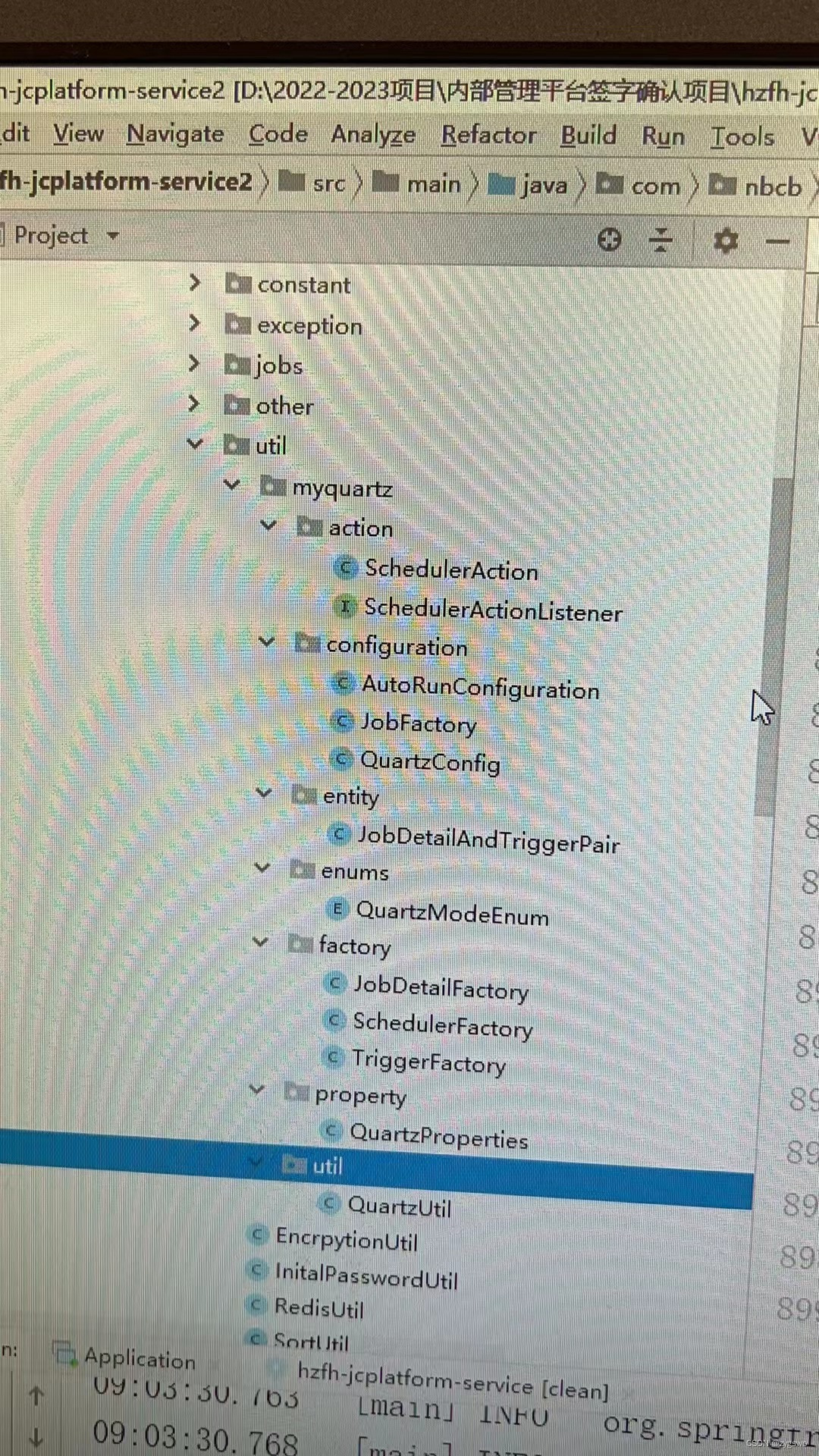
程序员成长之路心得篇——高效编码诀窍
随着AIGC的飞速发展,程序员越来越能够感受到外界和自己的压力。如何能够在AI蓬勃发展的时代不至于落后,不至于被替代?项目的开发效率起了至关重要的作用。 首先提出几个问题: 如何实现高效编程?高效编程的核心在于哪里ÿ…...
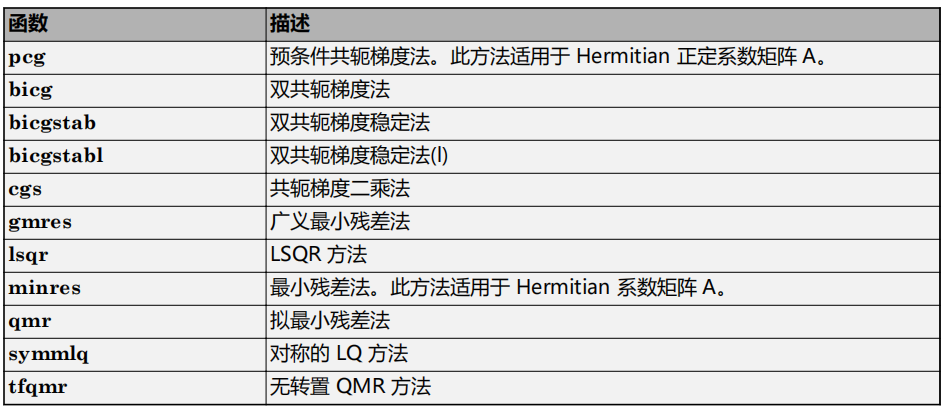
matlab使用教程(6)—线性方程组的求解
进行科学计算时,最重要的一个问题是对联立线性方程组求解。在矩阵表示法中,常见问题采用以下形式:给定两个矩阵 A 和 b,是否存在一个唯一矩阵 x 使 Ax b 或 xA b? 考虑一维示例具有指导意义。例如,方程 …...

Verilog语法学习——边沿检测
边沿检测 代码 module edge_detection_p(input sys_clk,input sys_rst_n,input signal_in,output edge_detected );//存储上一个时钟周期的输入信号reg signal_in_prev;always (posedge sys_clk or negedge sys_rst_n) beginif(!sys_rst_n)signal_in_prev < 0;else…...

springboot和springcloud的联系与区别
什么是springboot? Spring Boot是一个用于简化Spring应用程序开发的框架,它提供了一种约定优于配置的方式,通过自动配置和快速开发能力,可以快速搭建独立运行、生产级别的Spring应用程序。 在传统的Spring应用程序开发中…...
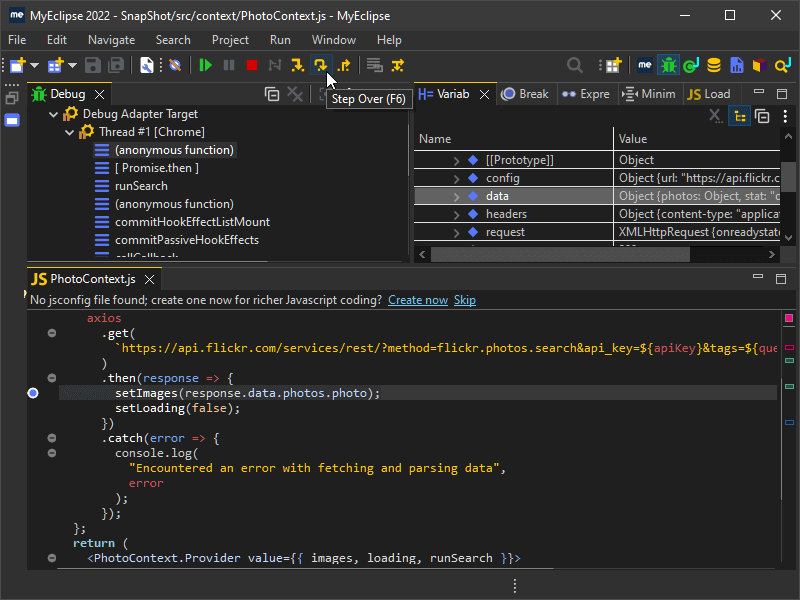
【Web开发指南】如何用MyEclipse进行JavaScript开发?
由于MyEclipse中有高级语法高亮显示、智能内容辅助和准确验证等特性,进行JavaScript编码不再是一项繁琐的任务。 MyEclipse v2023.1.2离线版下载 JavaScript项目 在MyEclipse 2021及以后的版本中,大多数JavaScript支持都是开箱即用的JavaScript源代码…...
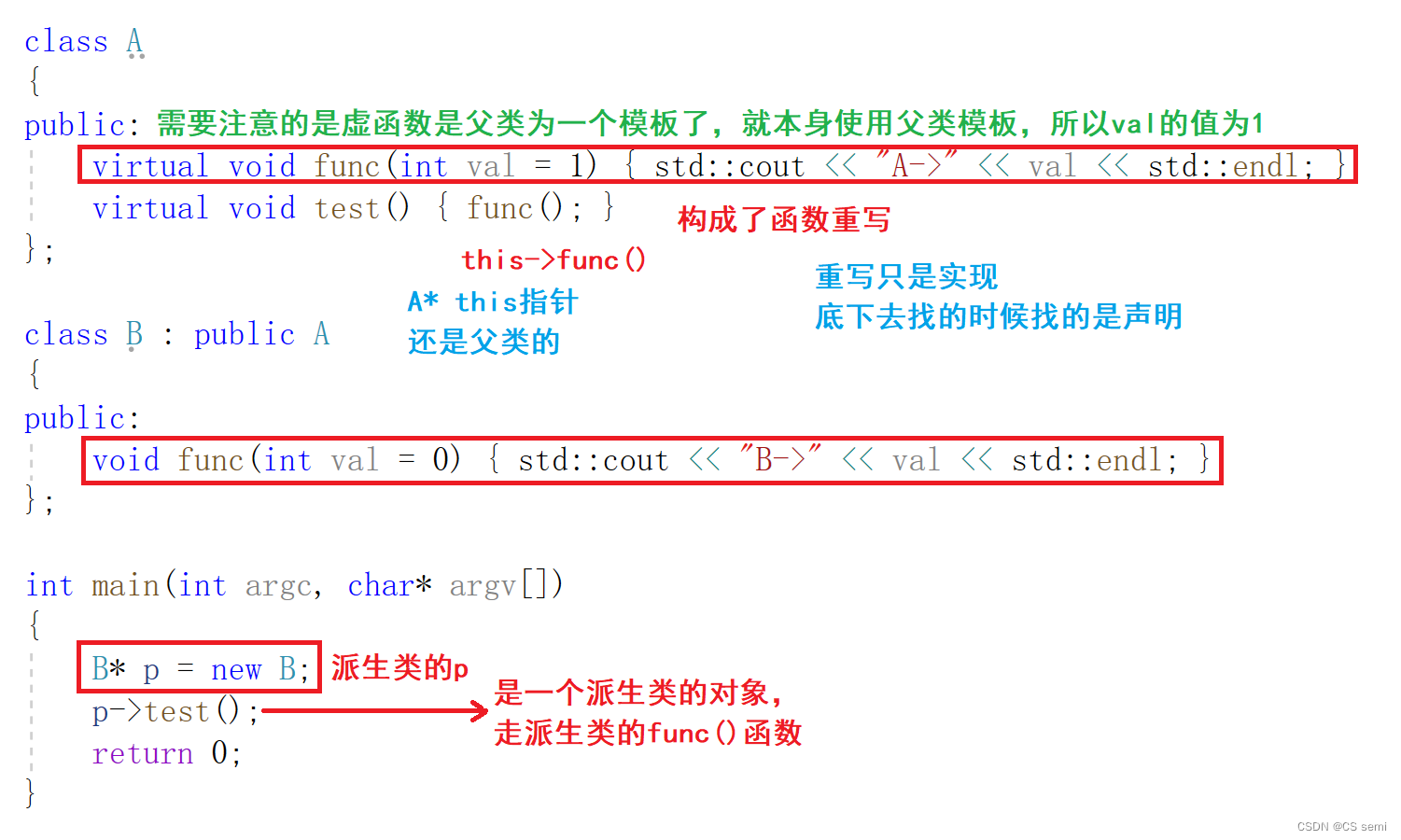
【C++进阶】多态
⭐博客主页:️CS semi主页 ⭐欢迎关注:点赞收藏留言 ⭐系列专栏:C进阶 ⭐代码仓库:C进阶 家人们更新不易,你们的点赞和关注对我而言十分重要,友友们麻烦多多点赞+关注,你们的支持是我…...

决策树的划分依据之:信息增益率
在上面的介绍中,我们有意忽略了"编号"这一列.若把"编号"也作为一个候选划分属性,则根据信息增益公式可计算出它的信息增益为 0.9182,远大于其他候选划分属性。 计算每个属性的信息熵过程中,我们发现,该属性的值为0, 也就…...

SolidUI社区-独立部署 和 Docker 通信分析
背景 随着文本生成图像的语言模型兴起,SolidUI想帮人们快速构建可视化工具,可视化内容包括2D,3D,3D场景,从而快速构三维数据演示场景。SolidUI 是一个创新的项目,旨在将自然语言处理(NLP)与计算机图形学相…...
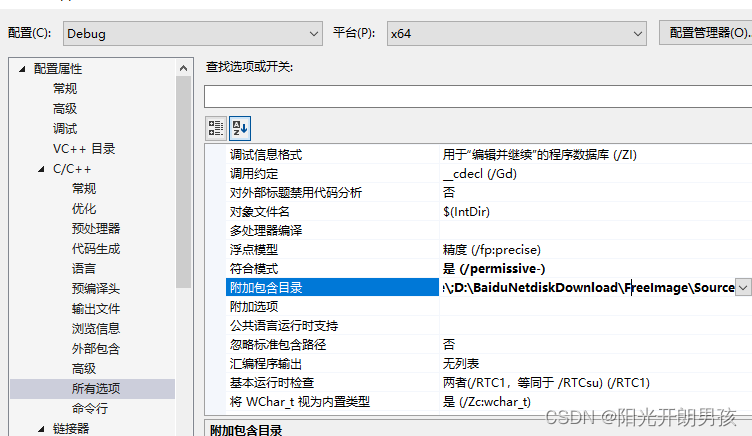
Windows下FreeImage库的配置
首先下载FreeImage库,http://freeimage.sourceforge.net/download.html,官网下载如下: 内部下载地址:https://download.csdn.net/download/qq_36314864/88140305 解压后,打开FreeImage.2017.sln,如果是vs…...
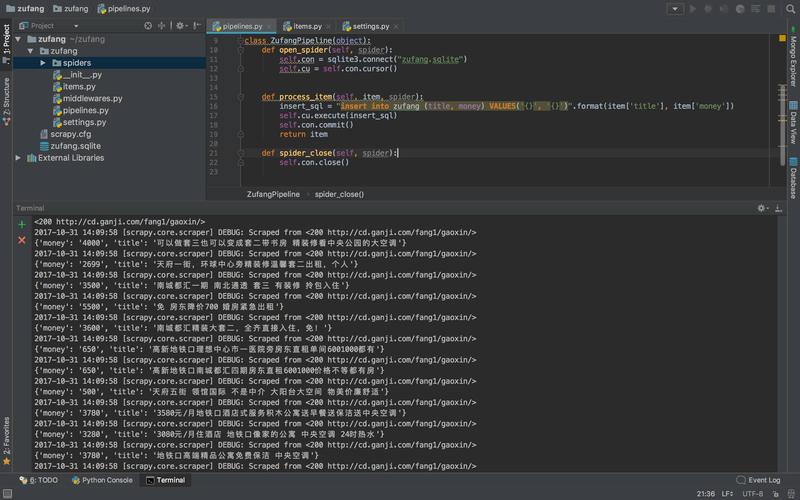
用python编写一个小程序,如何用python编写软件
大家好,给大家分享一下用python编写一个小程序,很多人还不知道这一点。下面详细解释一下。现在让我们来看看! 1、python可以写手机应用程序吗? 我想有人曲解意思了,人家说用python开发渣蔽一个手机app,不是…...

WPF实战学习笔记32-登录、注册服务添加
增加全局账户名同步 增加静态变量 添加文件:Mytodo.Common.Models.AppSession.cs ausing Prism.Mvvm; using System; using System.Collections.Generic; using System.ComponentModel; using System.Linq; using System.Text; using System.Threading.Tasks; us…...
XGBoost的参数
目录 1. 迭代过程 1.1 迭代次数/学习率/初始𝐻最大迭代值 1.1.1 参数num_boost_round & 参数eta 1.1.2 参数base_score 1.1.3 参数max_delta_step 1.2 xgboost的目标函数 1.2.1 gamma对模型的影响 1.2.2 lambda对模型的影响 2. XGBoost的弱评估器 2.…...
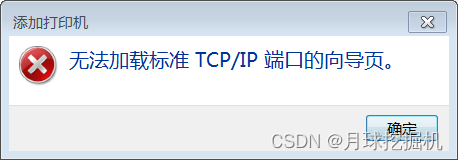
【已解决】windows7添加打印机报错:加载Tcp Mib库时的错误,无法加载标准TCP/IP端口的向导页
windows7 添加打印机的时候,输入完打印机的IP地址后,点击下一步,报错: 加载Tcp Mib库时的错误,无法加载标准TCP/IP端口的向导页 解决办法: 复制以下的代码到新建文本文档.txt中,然后修改文本文…...

19c补丁后oracle属主变化,导致不能识别磁盘组
补丁后服务器重启,数据库再次无法启动 ORA01017: invalid username/password; logon denied Oracle 19c 在打上 19.23 或以上补丁版本后,存在与用户组权限相关的问题。具体表现为,Oracle 实例的运行用户(oracle)和集…...

Leetcode 3576. Transform Array to All Equal Elements
Leetcode 3576. Transform Array to All Equal Elements 1. 解题思路2. 代码实现 题目链接:3576. Transform Array to All Equal Elements 1. 解题思路 这一题思路上就是分别考察一下是否能将其转化为全1或者全-1数组即可。 至于每一种情况是否可以达到…...

Zustand 状态管理库:极简而强大的解决方案
Zustand 是一个轻量级、快速和可扩展的状态管理库,特别适合 React 应用。它以简洁的 API 和高效的性能解决了 Redux 等状态管理方案中的繁琐问题。 核心优势对比 基本使用指南 1. 创建 Store // store.js import create from zustandconst useStore create((set)…...

Oracle查询表空间大小
1 查询数据库中所有的表空间以及表空间所占空间的大小 SELECTtablespace_name,sum( bytes ) / 1024 / 1024 FROMdba_data_files GROUP BYtablespace_name; 2 Oracle查询表空间大小及每个表所占空间的大小 SELECTtablespace_name,file_id,file_name,round( bytes / ( 1024 …...
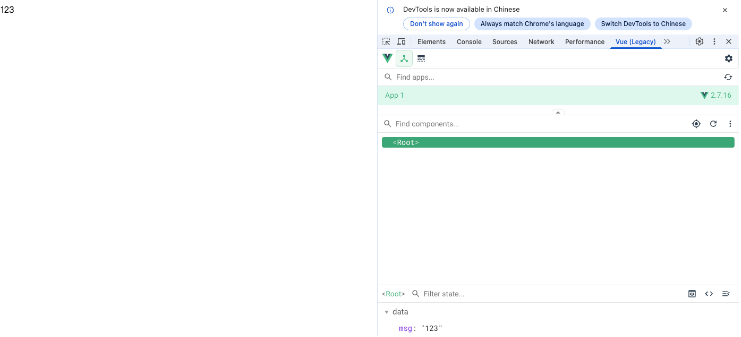
Vue2 第一节_Vue2上手_插值表达式{{}}_访问数据和修改数据_Vue开发者工具
文章目录 1.Vue2上手-如何创建一个Vue实例,进行初始化渲染2. 插值表达式{{}}3. 访问数据和修改数据4. vue响应式5. Vue开发者工具--方便调试 1.Vue2上手-如何创建一个Vue实例,进行初始化渲染 准备容器引包创建Vue实例 new Vue()指定配置项 ->渲染数据 准备一个容器,例如: …...

第25节 Node.js 断言测试
Node.js的assert模块主要用于编写程序的单元测试时使用,通过断言可以提早发现和排查出错误。 稳定性: 5 - 锁定 这个模块可用于应用的单元测试,通过 require(assert) 可以使用这个模块。 assert.fail(actual, expected, message, operator) 使用参数…...
可以参考以下方法:)
根据万维钢·精英日课6的内容,使用AI(2025)可以参考以下方法:
根据万维钢精英日课6的内容,使用AI(2025)可以参考以下方法: 四个洞见 模型已经比人聪明:以ChatGPT o3为代表的AI非常强大,能运用高级理论解释道理、引用最新学术论文,生成对顶尖科学家都有用的…...

以光量子为例,详解量子获取方式
光量子技术获取量子比特可在室温下进行。该方式有望通过与名为硅光子学(silicon photonics)的光波导(optical waveguide)芯片制造技术和光纤等光通信技术相结合来实现量子计算机。量子力学中,光既是波又是粒子。光子本…...

【Linux】Linux 系统默认的目录及作用说明
博主介绍:✌全网粉丝23W,CSDN博客专家、Java领域优质创作者,掘金/华为云/阿里云/InfoQ等平台优质作者、专注于Java技术领域✌ 技术范围:SpringBoot、SpringCloud、Vue、SSM、HTML、Nodejs、Python、MySQL、PostgreSQL、大数据、物…...
)
C#学习第29天:表达式树(Expression Trees)
目录 什么是表达式树? 核心概念 1.表达式树的构建 2. 表达式树与Lambda表达式 3.解析和访问表达式树 4.动态条件查询 表达式树的优势 1.动态构建查询 2.LINQ 提供程序支持: 3.性能优化 4.元数据处理 5.代码转换和重写 适用场景 代码复杂性…...
